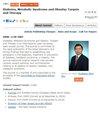索马里摩加迪沙 II 型糖尿病患者焦虑和抑郁症状的患病率和决定因素:一项横断面研究
IF 2.8
3区 医学
Q3 ENDOCRINOLOGY & METABOLISM
Diabetes, Metabolic Syndrome and Obesity: Targets and Therapy
Pub Date : 2024-09-14
DOI:10.2147/dmso.s479583
引用次数: 0
摘要
目的:本研究旨在确定索马里摩加迪沙TIIDM患者中抑郁、焦虑和压力的患病率,并找出预测因素,因为索马里对这些疾病的研究有限:2023年11月至2024年1月,在索马里首都埃尔多安医院对TIIDM成年患者进行了一项医院横断面研究。采用系统抽样技术共招募了 360 名参与者。采用问卷调查的方式收集了有关社会人口学、临床和行为特征的数据。抑郁、焦虑和压力量表(DASS-21)问卷用于评估抑郁、焦虑和压力症状。对结果变量进行了二元和多元逻辑回归分析,以确定预测结果变量的变量:在这项研究的 360 名参与者中,分别有 44.7%、55.0% 和 30.3% 的人有抑郁、焦虑和压力症状。据统计,缺乏定期锻炼(AOR = 1.79;95% CI:1.14- 2.79)和病程为 4-7 年(AOR = 1.94;95% CI:1.16- 3.23)与抑郁有关。女性(AOR = 2.07;95% CI:1.31- 3.28)、有≥ 9 个孩子(AOR = 1.94;95% CI:1.07- 3.53)和缺乏定期锻炼(AOR = 1.57;95% CI:1.01- 2.45)与焦虑在统计学上相关。缺乏规律锻炼(AOR = 2.07;95% CI:1.31- 3.28)、有糖尿病并发症(AOR = 2.14;95% CI:1.01- 4.54)、病程 4-7 年(AOR = 2.22;95% CI:1.25- 3.94)和不遵守糖尿病管理(AOR = 2.74;95% CI:1.20- 6.26)与压力有统计学相关性:本研究发现,TIIDM 患者的抑郁、焦虑和压力症状发生率中等偏高,缺乏体育锻炼与抑郁、焦虑和压力症状发生率增加有关。医护人员应筛查心理症状,提供干预措施,监测久坐不动的患者,并鼓励患者坚持治疗和体育锻炼,以减轻心理健康负担。 关键词:II型糖尿病;抑郁;焦虑;压力;摩加迪沙;索马里本文章由计算机程序翻译,如有差异,请以英文原文为准。
The Prevalence and Determinants of Anxiety and Depressive Symptoms in Patients with Type II Diabetes Mellitus in Mogadishu, Somalia: A Cross-Sectional Study
Purpose: This study aims to determine the prevalence of depression, anxiety, and stress among TIIDM patients in Mogadishu, Somalia, and identify predicting factors, as there is limited research on these disorders in Somalia.
Methods: A hospital-based cross-sectional study was conducted on adult patients with TIIDM from November 2023 to January 2024 at Erdogan Hospital, in the capital city of Somalia. A total of 360 participants were recruited using the systematic sampling technique. Data was collected using questionnaires on sociodemographic, clinical and behavioral characteristics. The depression, anxiety, and stress scale (DASS-21) questionnaire was used to assess symptoms of depression, anxiety, and stress. Bivariate and multivariate logistic regression analyses were performed to identify variables predicted by the outcome variables.
Results: Out of the 360 participants included in this study, 44.7%, 55.0%, and 30.3% had depression, anxiety, and stress symptoms, respectively. A lack of regular exercise (AOR = 1.79; 95% CI: 1.14– 2.79) and an illness duration of 4– 7 years (AOR = 1.94; 95% CI: 1.16– 3.23) were statistically associated with depression. Being female (AOR = 2.07; 95% CI: 1.31– 3.28), having ≥ 9 children (AOR = 1.94; 95% CI: 1.07– 3.53), and a lack of regular exercise (AOR = 1.57; 95% CI: 1.01– 2.45) were statistically associated with anxiety. A lack of regular exercise (AOR = 2.07; 95% CI: 1.31– 3.28), having DM complications (AOR = 2.14; 95% CI: 1.01– 4.54), an illness duration of 4– 7 years (AOR = 2.22; 95% CI: 1.25– 3.94), and DM management non-compliance (AOR = 2.74; 95% CI: 1.20– 6.26) were statistically associated with stress.
Conclusions: This study found that TIIDM patients had moderately high rates of depression, anxiety, and stress symptoms, with a lack of physical activity associated with increased odds of depression, anxiety, and stress symptoms. Healthcare workers should screen for psychological symptoms, provide interventions, monitor sedentary patients, and encourage adherence to treatment and physical exercise to reduce mental health burden.
Keywords: type II diabetes mellitus, depression, anxiety, stress, Mogadishu, Somalia
Methods: A hospital-based cross-sectional study was conducted on adult patients with TIIDM from November 2023 to January 2024 at Erdogan Hospital, in the capital city of Somalia. A total of 360 participants were recruited using the systematic sampling technique. Data was collected using questionnaires on sociodemographic, clinical and behavioral characteristics. The depression, anxiety, and stress scale (DASS-21) questionnaire was used to assess symptoms of depression, anxiety, and stress. Bivariate and multivariate logistic regression analyses were performed to identify variables predicted by the outcome variables.
Results: Out of the 360 participants included in this study, 44.7%, 55.0%, and 30.3% had depression, anxiety, and stress symptoms, respectively. A lack of regular exercise (AOR = 1.79; 95% CI: 1.14– 2.79) and an illness duration of 4– 7 years (AOR = 1.94; 95% CI: 1.16– 3.23) were statistically associated with depression. Being female (AOR = 2.07; 95% CI: 1.31– 3.28), having ≥ 9 children (AOR = 1.94; 95% CI: 1.07– 3.53), and a lack of regular exercise (AOR = 1.57; 95% CI: 1.01– 2.45) were statistically associated with anxiety. A lack of regular exercise (AOR = 2.07; 95% CI: 1.31– 3.28), having DM complications (AOR = 2.14; 95% CI: 1.01– 4.54), an illness duration of 4– 7 years (AOR = 2.22; 95% CI: 1.25– 3.94), and DM management non-compliance (AOR = 2.74; 95% CI: 1.20– 6.26) were statistically associated with stress.
Conclusions: This study found that TIIDM patients had moderately high rates of depression, anxiety, and stress symptoms, with a lack of physical activity associated with increased odds of depression, anxiety, and stress symptoms. Healthcare workers should screen for psychological symptoms, provide interventions, monitor sedentary patients, and encourage adherence to treatment and physical exercise to reduce mental health burden.
Keywords: type II diabetes mellitus, depression, anxiety, stress, Mogadishu, Somalia
求助全文
通过发布文献求助,成功后即可免费获取论文全文。
去求助
来源期刊

Diabetes, Metabolic Syndrome and Obesity: Targets and Therapy
Pharmacology, Toxicology and Pharmaceutics-Pharmacology
CiteScore
5.90
自引率
6.10%
发文量
431
审稿时长
16 weeks
期刊介绍:
An international, peer-reviewed, open access, online journal. The journal is committed to the rapid publication of the latest laboratory and clinical findings in the fields of diabetes, metabolic syndrome and obesity research. Original research, review, case reports, hypothesis formation, expert opinion and commentaries are all considered for publication.
 求助内容:
求助内容: 应助结果提醒方式:
应助结果提醒方式:


